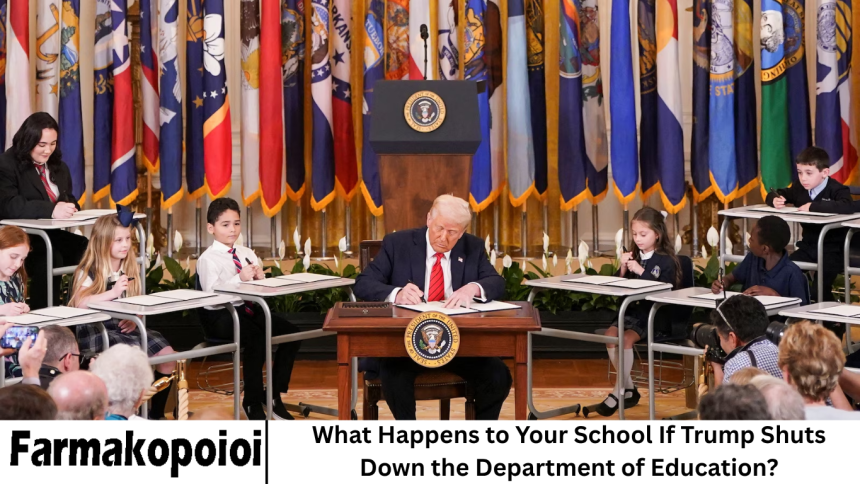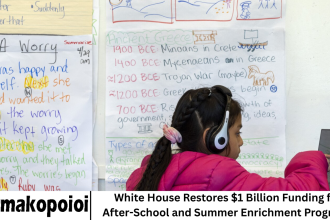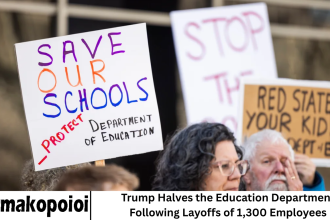When former President Donald Trump announced his plan to shut down the U.S. Department of Education, the statement sent ripples through the American education system. From teachers and administrators to parents and students, everyone began asking the same pressing question.
- The Department of Education: What It Does and Why It Exists
- Trump’s Plan to Eliminate the Department
- Funding Fallout: Who Loses and Who Gains
- States Take Control: The Pros and Cons
- Special Education and Civil Rights at Risk
- The Future of College Education and Student Loans
- How Schools Would Operate Without Federal Oversight
- Critics vs. Supporters: The National Debate
- What History Tells Us: Previous Attempts to Eliminate the Department
- What Experts Predict for the Future of U.S. Education
- Frequently Asked Question
- Conclusion
What would actually happen to our schools if the Department of Education disappeared? The idea of eliminating the department, first created in 1979 under President Jimmy Carter, isn’t entirely new. Conservatives have long criticized it as an unnecessary layer of federal bureaucracy that limits local control.
But Trump’s renewed push to dissolve it represents one of the most radical changes in U.S. education policy in decades — one that could reshape how schools operate, how funding is distributed, and even what children are taught.
More Read: White House Restores $1 Billion Funding for After-School and Summer Enrichment Programs
The Department of Education: What It Does and Why It Exists
The U.S. Department of Education (ED) plays a critical role in supporting and regulating the nation’s public and private schools. Established as a cabinet-level agency in 1979, it oversees billions in federal funding, ensures equal educational opportunities.
Collects national education data, and enforces key laws such as Title IX and the Individuals with Disabilities Education Act (IDEA).
Its core responsibilities include:
- Distributing Federal Funds: The department allocates money to states, districts, and schools through programs like Title I (for low-income students), Pell Grants (for college students), and IDEA (for students with disabilities).
- Enforcing Civil Rights: The Office for Civil Rights (OCR) ensures that schools comply with anti-discrimination laws related to race, gender, and disability.
- Data and Research: The National Center for Education Statistics (NCES) provides essential data that guide policymaking and help evaluate the nation’s education performance.
- Setting National Priorities: While states maintain control over curriculum and standards, the federal government influences priorities through funding incentives, such as the Every Student Succeeds Act (ESSA).
Without the department, these functions would have to be absorbed by other agencies — or handed off entirely to states.
Trump’s Plan to Eliminate the Department
Trump’s calls to eliminate the Department of Education stem from his belief that education should be a state and local responsibility. In his second-term agenda, “Agenda 47,” Trump outlined a plan to dismantle the department, slash its funding, and transfer many of its responsibilities to the states or other federal offices.
His argument rests on several key points:
- Reducing Bureaucracy: Trump contends that the federal government’s involvement in education has grown too large and inefficient.
- Local Control: He argues that local communities should have more say in curriculum, testing, and policy decisions without federal interference.
- Parental Rights: Trump and his allies emphasize returning control of education to parents, particularly regarding what schools can teach about race, gender, and sexuality.
- Cost Savings: The administration claims shutting down the department could save billions in federal spending.
However, critics say the move could devastate federal aid systems, deepen inequality, and dismantle decades of progress in educational equity.
Funding Fallout: Who Loses and Who Gains
If the Department of Education were to shut down, one of the most immediate and visible consequences would be the disruption of federal funding. In the 2024 fiscal year, the department’s budget exceeded $80 billion, supporting millions of students nationwide.
Potential Impacts on K–12 Schools
- Title I Grants: Over 50,000 public schools serving low-income students rely on Title I funding. Eliminating or decentralizing these funds could leave struggling schools without essential resources for reading programs, after-school tutoring, and teacher support.
- Special Education: IDEA funding supports millions of students with disabilities. If the program’s oversight were fragmented across states, consistency and accountability might vanish.
- Teacher Training and Innovation Grants: Federal grants help schools recruit, train, and retain teachers, particularly in high-need areas such as STEM and special education. These could disappear or become state-funded, creating disparities between wealthy and poor districts.
Impact on Higher Education
- Pell Grants and Student Loans: The Federal Student Aid (FSA) office provides more than $100 billion in loans, grants, and work-study funds annually. Without a central authority, it’s unclear who would manage this system — potentially throwing college financing into chaos.
- Accreditation and Oversight: The department also ensures quality control among colleges through accreditation standards. Eliminating it could lead to a “Wild West” of unregulated institutions, predatory for-profit colleges, and unreliable degrees.
The loss of federal oversight would likely benefit private and charter schools that thrive on deregulation but could harm public education systems already stretched thin.
States Take Control: The Pros and Cons
Trump’s proposal would shift education authority to the states, giving governors and local education agencies more autonomy.
Potential Advantages:
- Localized Decision-Making: States could design curricula tailored to local values and economic needs.
- Reduced Bureaucracy: Less red tape could speed up innovation and responsiveness.
- Increased Parental Involvement: Advocates argue parents would have more influence over educational decisions.
Major Drawbacks:
- Funding Inequities: States with lower tax revenues could struggle to maintain school quality without federal assistance.
- Civil Rights Protections: Without federal oversight, states might not enforce anti-discrimination laws uniformly.
- Data Gaps: The loss of nationwide education data would hinder policymakers and researchers.
In essence, while wealthier states might thrive under a decentralized system, poorer regions could face severe setbacks — exacerbating the “education gap” between rich and poor districts.
Special Education and Civil Rights at Risk
Perhaps the most alarming consequence of dismantling the Department of Education involves the fate of students with disabilities and marginalized groups.
The department’s Office for Civil Rights (OCR) and the Office of Special Education Programs (OSEP) ensure compliance with laws like:
- Title IX (gender equality)
- IDEA (disability education rights)
- Section 504 of the Rehabilitation Act
- Title VI (prohibition of race discrimination)
Without these offices, enforcement would rely entirely on state governments, which have varying levels of commitment and resources.
Real-World Consequences:
- Students with disabilities could lose access to individualized education programs (IEPs).
- Victims of discrimination might have fewer options to report violations.
- Federal investigations into school bias, harassment, or inequitable discipline could vanish entirely.
The result could be a rollback of decades of progress toward inclusive and equitable education.
The Future of College Education and Student Loans
Beyond K–12, eliminating the Department of Education would throw the higher education landscape into uncertainty.
Currently, over 43 million Americans hold student loans managed by the federal government. If the department were shut down, control of these loans could shift to private lenders or another federal agency like the Treasury Department.
Possible Scenarios:
- Privatization of Student Loans: Banks could take over lending, reintroducing the high-interest, profit-driven model that federal loans were designed to replace.
- Reduced Access to College: Without Pell Grants and federal aid, millions of low-income students might be priced out of higher education.
- Loss of Oversight: The crackdown on predatory for-profit colleges could weaken, allowing diploma mills to thrive again.
For students, this would mean fewer protections, higher debt, and limited access to affordable education.
How Schools Would Operate Without Federal Oversight
If the Department of Education were to close, schools would not shut down overnight — education is primarily a state and local responsibility. However, daily operations would shift dramatically.
What Could Change:
- Curriculum: States would have full control over what’s taught. Some might emphasize civics and traditional values, while others focus on STEM and equity-based learning.
- Standardized Testing: Federal testing mandates under ESSA could vanish, leaving states to set their own benchmarks.
- Teacher Credentials: States might create their own certification standards, which could vary widely.
- Funding Streams: States would need to replace lost federal funds or make deep cuts.
- Accountability Systems: Without national oversight, comparing school performance across states would become nearly impossible.
The overall effect could be a patchwork of education systems — some high-performing, others underfunded — leading to deep national disparities.
Critics vs. Supporters: The National Debate
Supporters of the Closure Argue:
- Federal involvement has not improved education outcomes.
- Parents and teachers know best what their communities need.
- Local control allows for more freedom, innovation, and values-based education.
Critics Warn:
- The absence of federal oversight will deepen inequality.
- Vulnerable students — low-income, minority, or disabled — will lose protections.
- National competitiveness will decline without unified standards or investment.
Even among conservatives, opinions vary. Some argue for downsizing rather than total elimination, suggesting reforms like merging the Department of Education with the Department of Labor or transforming it into a grant-administration office.
What History Tells Us: Previous Attempts to Eliminate the Department
Efforts to dismantle the Department of Education are not new. Ronald Reagan famously campaigned on the same promise in 1980 but eventually backed down due to bipartisan resistance and public concern.
In the decades since, multiple Republican lawmakers have proposed similar measures, but none gained serious traction. The main reason: eliminating the department requires Congressional approval, and many members — even conservatives — represent states that depend heavily on federal education funding.
This historical pattern suggests that while Trump’s proposal may ignite debate, actually shutting down the department would face immense political and logistical challenges.
What Experts Predict for the Future of U.S. Education
Experts remain divided on whether Trump could realistically follow through on his plan, but most agree it would cause major disruption.
Optimists believe:
- Decentralization could empower innovation and flexibility.
- States might collaborate to create regional education frameworks.
- Private and charter schools could flourish under deregulation.
Pessimists warn:
- Federal aid cuts would devastate low-income districts.
- Student debt management could spiral into chaos.
- Education inequality would surge, undermining national unity and competitiveness.
Ultimately, the outcome would depend on how states respond — and whether new systems could be built fast enough to replace what the Department of Education currently provides.
Frequently Asked Question
Would schools close immediately if the Department of Education shut down?
No. Schools are primarily run by state and local governments, so they would continue operating. However, funding gaps and administrative confusion would arise as federal programs are dismantled.
What happens to student loans and Pell Grants?
Federal student aid programs, including Pell Grants and loans, are managed by the Department of Education. Their removal could shift responsibilities to private lenders or the Treasury, likely making loans more expensive and less accessible.
How would this affect teachers?
Federal grants for training, professional development, and innovation could disappear, leaving states to fill the gap. Teacher shortages might worsen, especially in underfunded districts.
Will states gain full control over curriculum?
Yes. Without federal oversight, states could design their own curricula and standards, leading to major variations in what students learn across the country.
What about special education and civil rights protections?
The loss of federal offices like the OCR and OSEP could weaken enforcement of laws protecting students with disabilities and against discrimination, leaving states to decide how — or if — to uphold them.
Could Congress actually approve the department’s closure?
It would be extremely difficult. Shutting down a federal agency requires legislative approval, and many lawmakers, even conservatives, rely on federal education funds for their states.
What’s the most likely outcome if Trump pursues this plan?
Rather than a full shutdown, experts predict a significant downsizing or restructuring of the Department of Education — reducing its budget, eliminating some programs, and devolving more power to states.
Conclusion
The idea of shutting down the U.S. Department of Education may sound appealing to those frustrated with federal overreach, but the reality is far more complex. The department touches nearly every corner of America’s education system — from kindergarten classrooms to college campuses.
Its closure would trigger a cascade of changes affecting funding, equity, accountability, and opportunity. Wealthier districts might adapt smoothly, while poorer ones could struggle to survive. Students with disabilities, minorities, and those relying on federal aid would face the greatest risks.






















